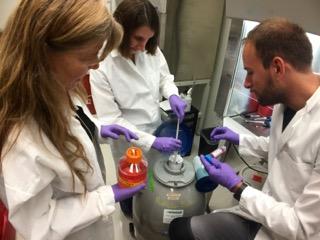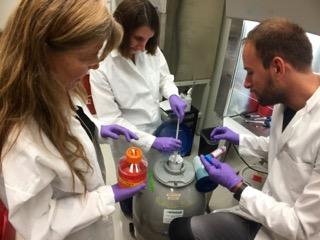
Changes in cellular metabolites have been shown to regulate embryonic stem cell development at the earliest stages of life. Metabolites are simple compounds generated during life-sustaining chemical activities in cells.
The recent findings should improve scientists' ability to use embryonic stem cells to grow new tissues and organs to replace those damaged by disease or injury. The findings also could lead to new treatments for common disorders ranging from infertility to cancer.
The researchers reported on their study in the Nov. 16 issue of the journal Nature Cell Biology.
After fertilization, a human egg begins to travel down the fallopian tube. As it does, it begins to divide to form a ball of embryonic cells. Each of these cells, called naive, pre-implantation embryonic cells, has the capacity to develop into any cell type in the human body, an ability called pluripotency.
When the developing embryo enters the uterus, it must implant into the uterine lining if the pregnancy is to proceed. When this occurs, the naive stem cells undergo a critical change as they take the first step toward differentiating into specific cell types, such as gut, muscle or nerve cells. Such cells are called primed embryonic stem cells.
"Implantation to mother's uterus is arguably one of the hardest things we ever have to do in life," said Ruohola-Baker, University of Washington professor of biochemistry and associate director of the UW Institute for Stem Cell and Regenerative Medicine, who led the research team. "In fact, most embryos fail to successfully implant and the pregnancy ends."
Scientists in the field of tissue regeneration are particularly interested this shift. Although primed, post-implantation embryonic stem cells can still turn into any type of human cell, they are more difficult to work with than the pre-implantation, naive cells.
To find out more about the differences between naive and primed pluripotent cells, the UW researchers first compared their gene expression profiles. This work, conducted by Yuliang Wang, now a senior research associate at Oregon Health & Science University, uncovered intriguing differences involving genes that affect the cells' metabolism.
"The expression of the metabolic genes, particularly those related to the function of mitochondria, was much higher in the naive cells," Wang said. "There was also a big difference in gene expression of a specific enzyme called nicotinamide N-methyltransferase."
To determine the effect of these changes, Henrik Sperber, a graduate student in the Ruohola-Baker laboratory, used a technique called mass spectroscopy to compare levels within cells of the metabolites.
The approach, called metabolomic analysis, provides a 'chemical snapshot' that pictures in great detail what is going on within cells at a specific stage. Just by looking at the cells metabolomic profiles, researchers saw it was possible to distinguish between naive and primed pluripotent cells.
The telltale metabolite that was found to be enriched in naive cells was methylnicotinamide, abbreviated MNA, a product of the metabolic enzyme whose levels increase in many cancers — nicotinamide N-methyltransferase, abbreviated NNMT.
When active, NNMT consumes a methyl group from a compound called S-adenosyl methionine. This methyl group is normally used in a gene regulation process called epigenetic histone methylation.
Without an adequate supply of the S-adenosyl methionine, regulation by histone methylation — and therefore correct gene expression — cannot take place.
The researchers found that in the naive cells NNMT was active and behaved as a metabolic 'methyl-sink' by lowering the level of methyl groups available. It thereby limited gene repression by epigenetic histone methylation.
In the primed cells, on the other hand, NNMT activity was low. As a result, S-adenosyl methionine was available for these epigenetic modifications that are required for a cell to enter the primed state.
In fact, by knocking out specific genes through CRISPR gene-editing technology, Julie Mathieu, acting instructor in Ruohola-Baker laboratory, demonstrated that it was possible to stabilize the cells in either the primed or naive state by manipulating NNMT activity alone.
"Our findings indicate that metabolites alone appear to be able drive many of the key changes in cellular function and differentiation," Ruohola-Baker said. "In addition to advancing our understanding of human embryonic development, the findings suggest we may be able to use metabolites, relatively simple compounds, to alter cell fate in the treatment of common disorders."
For example, such an approach might eventually form the basis for treating the most common cause of infertility — the failure of the embryo to successfully implant — or for affecting the cellular changes that lead to the development of cancer.
###
This work was supported by the American Heart Association, The Ellison Medical Foundation, the Schultz Fellowship for Health Sciences, the National Institutes of Health, and the National Heart Lung and Blood Institute Progenitor Cell Biology Consortium.





